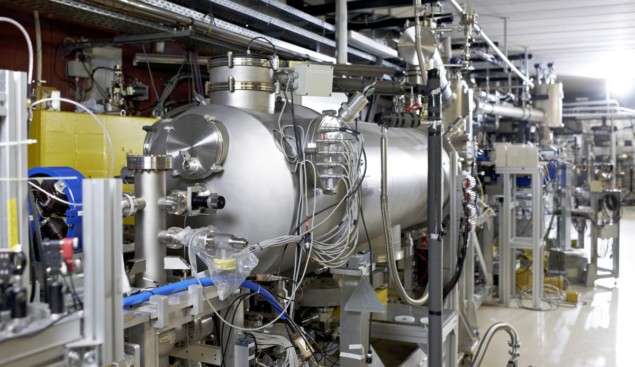Fast electrons accelerate the production of medical isotopes
31 Mar 2022

A new method for producing medical radioisotopes has passed its first milestone, by exposing a target to an electron beam at energy densities several orders of magnitude higher than found at the core of the Sun. This achievement paves the way for alternative radioisotope production methods using electron accelerators that do not require enriched uranium and produce little nuclear waste.
Medical radioisotopes
Technetium-99m (99mTc) is a metastable radionuclide that emits gamma radiation which can be detected in the body by a medical gamma camera. It is used in tens of millions of diagnostic procedures annually, making it the most commonly used medical radioisotope in the world. 99mTc is formed by the decay of its parent nuclide molybdenum-99 (99Mo), which comes from fission products created in neutron-irradiated uranium-235 targets in nuclear reactors.
Currently, the majority of 99Mo is produced from high-enriched uranium at five nuclear research reactors around the world. Smaller amounts are produced from low-enriched uranium in at least three reactors. But this dependency on nuclear reactors creates issues in itself, as several are ageing and cannot keep up with the demand.
Accelerating the production
An alternative concept, and one that does not require the use of nuclear reactors, is being developed by the SMART project – an international collaboration led by the Belgian Institute of Radio Elements (IRE) and also including the Dutch companies Demcon and ASML. The idea is to produce 99Mo by irradiating the non-radioactive molybdenum-100 (100Mo) with an intense beam of accelerated electrons. The approach requires no enriched uranium and produces hardly any long-lived radioactive waste.
ASML originally studied accelerated electron beams for use in a free electron laser to generate extreme ultraviolet light for lithography applications. The company then realized that, in contrast with present electron accelerators, its technology could be scaled to meet the specifications needed for large-scale radioisotope production. The SMART project aims to turn this idea into a commercial production facility.
With the SMART electron accelerator still under development, the researchers needed to pass several critical design milestones. One of these was to show that their 100Mo target could withstand prolonged exposure to the extreme intensity of the irradiation. The tests were performed on a 1:1000 scale, compared with the intended size for 99Mo production, using the ELBE superconducting electron accelerator at the Helmholtz Zentrum Dresden-Rossendorf (HZDR).
Feeling the heat
During these tests, the team exposed a millimetre-sized molybdenum target to a tightly focused 30 kW electron beam for 115 hours straight, which is the time needed for isotope production. The biggest obstacle with such extreme exposure is that the target would evaporate within milliseconds if not properly cooled.
With temperatures reaching between 200 and 600 °C, using water for cooling is not an option. Also gas cannot remove heat quickly enough. Instead, the researchers turned to liquid metal. The advantage of liquid metals is their high specific heat capacity and conductivity, which makes them highly effective in removing heat.
The team chose liquid sodium as a coolant as it is already used in other nuclear applications – although it does bring its own challenges. Sodium reacts heavily with air and water and can dissolve other metals. It is also solid at room temperature and, if some crucial parts in the system malfunction, it will cool down and clog the pipes, jeopardizing the entire process. The test run, however, demonstrated that liquid sodium is an effective coolant for this task. The target survived five consecutive days of extreme radiation.READ MORE

According to lead engineer Bas Vet from Demcon, the challenges brought together several disciplines: “Not only is the liquid sodium extremely challenging to work with, it is also used in one of the most extreme conditions that we can ever produce on Earth”. He points out that the power density deposited in the target is nine orders of magnitude higher than produced in the solar core, adding that the radiation environment is comparable to that received by a reactor vessel wall in a nuclear plant over 10 years – but delivered in just five days.
Even though the tests were done with a target scaled down in size, the experiments achieved the intended power density. Further steps will involve scaling up to final industrial proportions. The SMART project has defined the design of the final factory, including specifics for the target, its environment and the cooling, as well as the system that processes the irradiated target.
The international consortium is hopeful that by 2028 there will be a factory producing radioisotopes for hospitals worldwide.
from physicsworld.com 4/4/2022
Δεν υπάρχουν σχόλια:
Δημοσίευση σχολίου